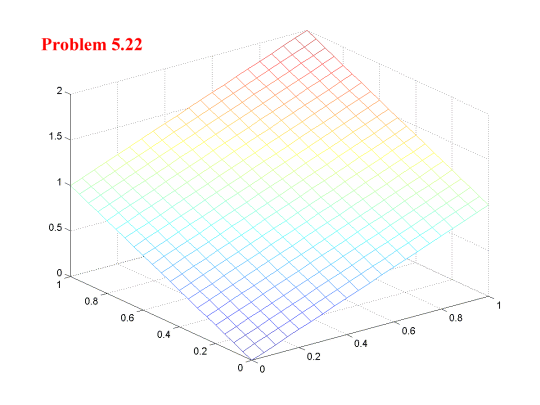The counterpart to this for distributions is:
g1(x|y) = f(x,y)/f2(y) , where f2(y) > 0, the conditional distribution of x given y;
and
g2(y|x) = f(x,y)/f1(x) , where f1(x) > 0, the conditional distribution of y given x.
These are legal probability distributions. To see this:
ò-¥+¥ g1(x|y)dx = ò-¥+¥ [f(x,y)/f2(y)]dx =
[1/f2(y)] [ò-¥+¥ f(x,y)dx] = [1/f2(y)][f2(y)] = 1
Note that, with respect to f(x,y), conditional distributions are one-variable distributions because the value of one variable has been specified. If X and Y are Independent, then g1(x|y) = f1(x) and g2(y|x) = f2(y).
To see this: g1(x|y) = f(x,y)/f2(y) = [f1(x)f2(y)]/f2(y) = f1(x).
Example:
æ (1/12)(x - 2y)
ç x = 2,3,4
f(x,y) = ç y = 0,1
ç
è 0 otherwise
Which yields the table:
y
0 1
------------
2 | 2 0 | 2
| |
x 3 | 3 1 | 4
| |
4 | 4 2 | 6
| |
---------------
9 3 |12
To get g2(y|x=4) = f(4,y)/f1(4) =
æ 4/6 y = 0 because f(4,0)/f1(4) = (4/12)/(6/12)
ç
g2(y|4) = ç 2/6 y = 1 because f(4,1)/f1(4) = (2/12)/(6/12)
ç
è 0 otherwise
To get g1(x|y=1) = f(x,1)/f2(1) =
æ 0 x = 2
ç
ç 1/3 x = 3
g1(x|1) = ç
ç 2/3 x = 4
ç
è 0 otherwise
Problem 5.22 p.208
æ y1 + y2
ç 0 < y1 < 1
f(y1,y2) = ç 0 < y2 < 1
ç
è 0 otherwise

-
f1(y1) =
ò01
f(y1, y2)dy2 =
ò01
(y1 + y2)dy2 =
[y1y2 + (y2)2)/2]|10 =
y1 + 1/2
Hence:
æ y1 + 1/2 æ y2 + 1/2
ç ç
f1(y1) = ç 0 < y1 < 1 f2(y2) = ç 0 < y2 < 1
ç ç
è 0 otherwise è 0 otherwise
P[Y1 ³ 1/2 | Y2 ³ 1/2] = P[Y1 ³ 1/2 Ç Y2 ³ 1/2]/P[Y2 ³ 1/2]
Working the Numerator first:
ò1/21 ò1/21 (y1 + y2)dy1dy2 = ò1/21 [(y1)2)/2 + y1y2]|11/2 dy2 =
ò1/21 [1/2 + y2 - 1/8 - (y2)/2]dy2 = ò1/21 [3/8 + (y2)/2]dy2 =
[(3/8)y2 + (y2)2)/2]|11/2 = 3/8
To get the Denominator we can use the marginal distribution from (a):
P(Y2 ³ 1/2) = ò1/21 [y2 + 1/2]dy2 = [(y2)2)/2 + (1/2)y2]| 11/2 = 5/8
Hence, the answer is (3/8)/(5/8) = 3/5
Solve: P[Y1 ³ 1/2 | Y2 = 1/2]
Note that, although this looks like:
P[Y1 ³ 1/2 | Y2 ³ 1/2]
it is very different! Here we are only dealing with one variable whereas in (b) we were dealing with two variables. In part (b) the answer was the ratio of two volumes. Here the answer is the area under a curve which is a slice through the bivariate distribution.
To solve this problem we need g1(y1|y2 = 1/2)
In this case, we can use (a) to get:
g1(y1|y2 = 1/2) = f(y1, y2)/f2(y2) = (y1+ y2)/(y2 + 1/2) = (y1+ 1/2)/(1/2 + 1/2) = y1+ 1/2
Hence:
æ y1 + 1/2
ç 0 < y1 < 1
g(y1|y2=1/2) = ç
ç
è 0 otherwise
Hence:
ò3/41 [y1 + 1/2]dy1 = [(y1)2)/2 + y1/2]| 13/4 = 11/32
